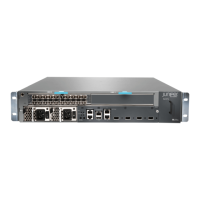Figure 48: Installing a Dual-Wide MIC
Replacing an MX5, MX10, MX40, and MX80 SFP or XFP Transceiver
Small form-factor pluggable transceivers (SFPs) and 10-gigabit small form-factor
pluggables (XFPs) are optical transceivers that are installed in a MIC. SFPs and XFPs are
hot-insertable and hot-removable.
•
Removing an MX5, MX10, MX40, and MX80 Transceiver on page 111
•
Installing an MX5, MX10, MX40, and MX80 Transceiver on page 112
Removing an MX5, MX10, MX40, and MX80 Transceiver
Removing an SFP or XFP transceiver does not interrupt MIC functioning, but the removed
SFP or XFP no longer receives or transmits data.
To remove an SFP or XFP transceiver (see Figure 49 on page 112):
1. Have ready a replacement transceiver or a transceiver slot plug, an antistatic mat,
and a rubber safety cap for the transceiver.
2. Attach an ESD grounding strap to your bare wrist and connect the strap to one of the
ESD points on the chassis.
3. Label the cables connected to the transceiver so that you can reconnect them correctly
later.
WARNING: Do not look directly into a fiber-optic transceiver or into the
ends of fiber-optic cables. Fiber-optic transceivers and fiber-optic cables
connected to a transceiver emit laser light that can damage your eyes.
4. Remove the cable connector from the transceiver.
5. Pull the ejector handle out from the transceiver to unlock the transceiver.
CAUTION: Make sure that you open the ejector handle completely until
you hear it click. This prevents damage to the transceiver.
111Copyright © 2019, Juniper Networks, Inc.
Chapter 4: Maintaining Components

